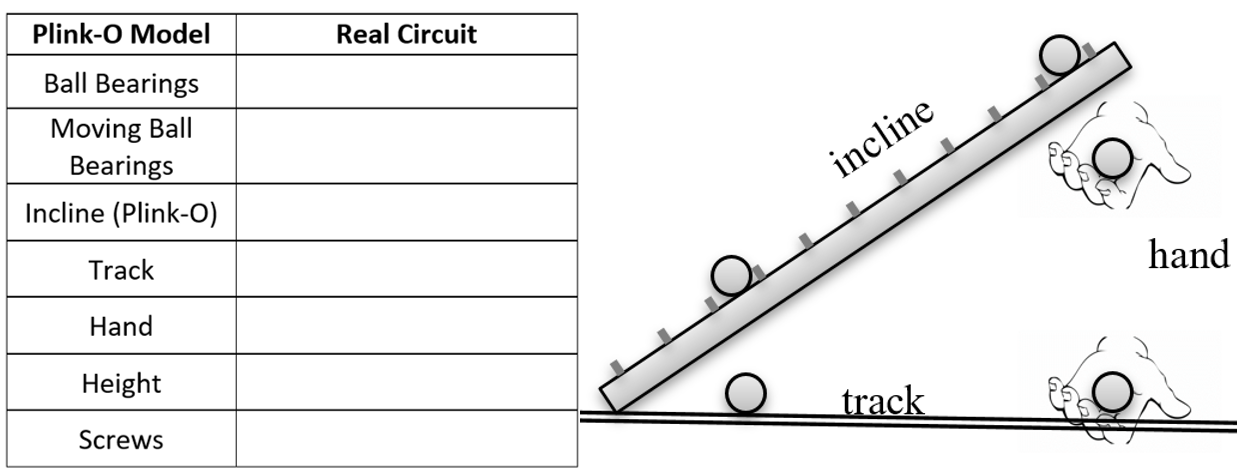Chris Meyer, President, Ontario Association of Physics Teachers
chris_meyer1@sympatico.ca
When it comes to the study of electricity, it is the simplest ideas that students understand the worst. This is because electricity does its thing invisibly, so our job as teachers is to help make those microscopic goings-on visible. To do this, we create conceptual models that allow us to visualize what happens inside a circuit. I would like to share with you the resources I have created.
The first uses a
Plinko model for electric circuits. Here is the model:

And here is my first task for you: use observations from the video above to decide what parts or characteristics of a real circuit the model parts represent. Fill in this chart before you go any further!


With your chart complete, you're ready for this next video to check your ideas.

All models of electric circuits have their strengths and weaknesses. One strength of the Plinko model is how it helps us think about energy in an electric circuit based on the
Drude model from 1900. One weakness is that the incline representing the load and the track representing the wire appear mostly empty of conduction electrons. To be more realistic, both the incline and the track should be “full” of steel ball bearings (or roughly one ball bearing for each screw, for example). I also carefully edited the video so it starts with ball bearings moving in every part of the circuit. If I used this apparatus in class, there would be a short interval before I get the first few steel ball bearings going when much of the circuit appears empty of electrons. This would lead to misconceptions similar to the water pipe model for circuits, where students can easily imagine pipes empty of water (i.e. empty of electrons).
The Language of Energy
A careful use of language really helps the discussion of energy. Start by defining a system: the set of objects whose properties and energies we choose to track. When the system interacts with objects outside it, energy transfers in or out of the system. This language makes the task of thinking about energy much clearer. In electric circuits, our system is the entire set of conduction electrons: the electrons that are free to move in a metal. With my grade nines and elevens, I simply call this “the system of electrons”. In the Plinko model, the hand (which represents the source) adds energy to the system by lifting the steel ball bearings. As the ball bearings travel down the incline, they collide with the screws, which represent atoms (or positively charged ionic cores of atoms) in the load. Each collision transfers energy from the ball bearing to the screw, representing an energy transfer from the conduction electron to the atom of the load. One limitation of this model is that we don't see evidence for a change in energy for the screw when we see the steel ball bearing slow down as a result of the collision.
Modelling Atoms in a Load
To understand better what happens to the atoms in a load, I have created a separate ball and spring model of the load that replaces the board and screws. We introduce this ball and spring model in our study of static electricity. The red spheres represent positively charged ionic atom cores, and the springs represent the bonds that hold the atoms together as in a solid. In my model, I had to remove some of those bonds to allow the electrons to travel through the solid.

Now that the screws are replaced with the red spheres, we can see clear evidence for a transfer of energy as the steel ball bearings slow down, and the red spheres move and begin to vibrate. To improve this model, the red spheres should be much more massive than the steel ball bearings, and more firmly held in place. Nevertheless, the key idea is visually represented: atoms in the load begin to vibrate as a result of collisions with the conduction electrons. While we cannot see this happening in a piece of metal, there is strong evidence that supports this understanding.

As the collisions occur, the atoms in the steel wool vibrate faster and faster, heat up, and begin to produce light. This is a great connection to the particle model of matter (the kinetic molecular theory) which I always try to reinforce in grade 9 science.
Two Lessons On Energy in a Circuit
When we explore these ideas in grade 9 science, we use these
two lessons. My full set of teaching resources for the electricity unit is
here. In grade 11 physics, we follow
very similar lessons. I hope this short article helps you teach electricity. Good luck, and feel free to ask if you have questions.
Tags: Electricity


